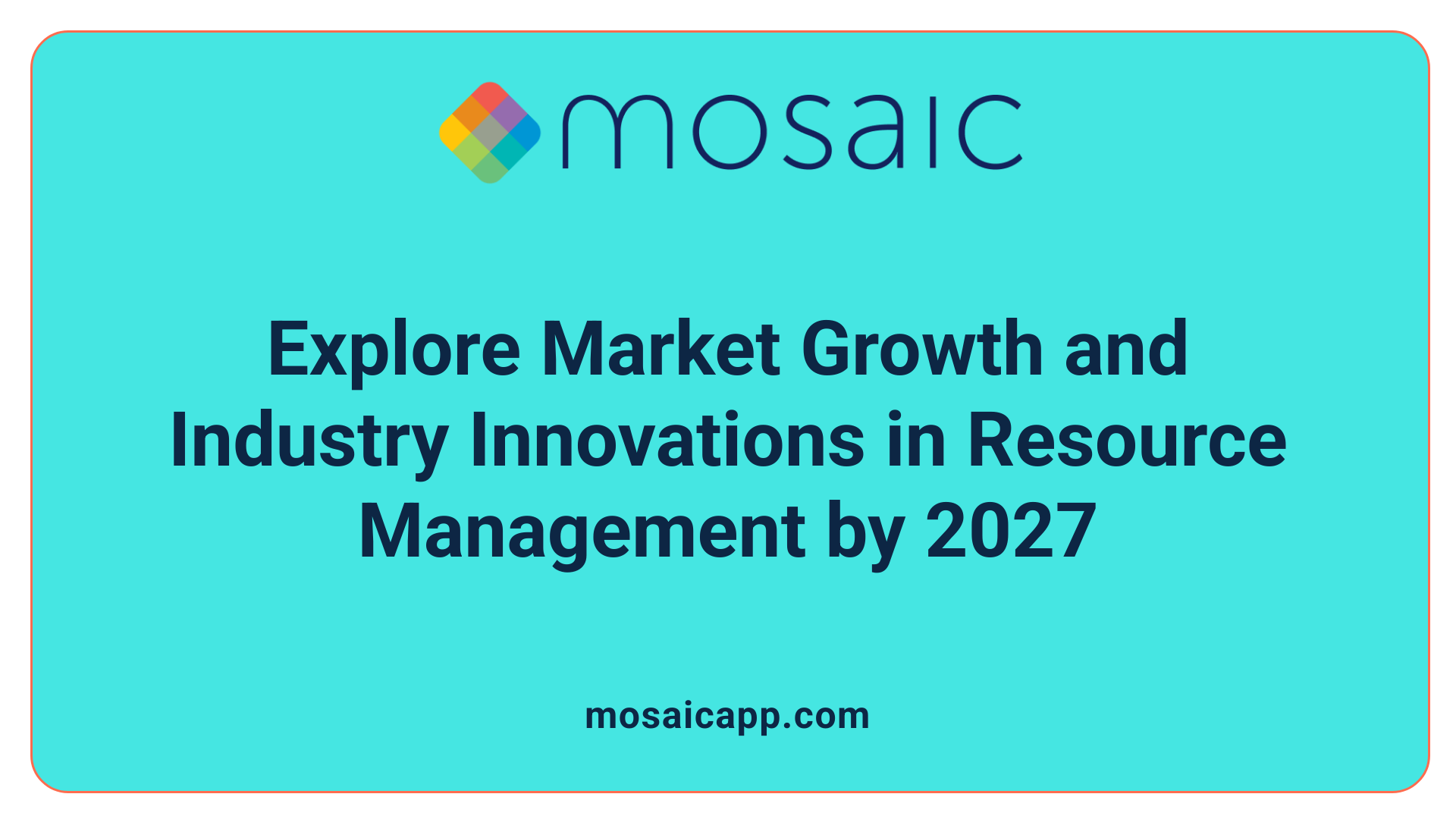Setting the Stage for 2027
As organizations worldwide prepare for the technological leap into 2027, resource management stands at the forefront of digital transformation. With an anticipated workforce of 88 million in project management alone, the evolution of resource management tools promises to revolutionize how companies allocate, track, and optimize their resources. This article explores the most anticipated features, trends, and technological innovations shaping resource management systems by 2027, spotlighting a future where automation, AI, and data analytics redefine operational excellence.
Key Improvements in Resource Management Platforms by 2027

What key improvements are forecasted for resource management platforms and software by 2027?
By 2027, resource management tools are expected to evolve significantly, incorporating a range of advanced features designed to enhance efficiency and decision-making. One major development is deeper integration with human resources (HR) and productivity systems. These platforms will seamlessly connect with HRIS, learning management systems (LMS), and collaboration tools, enabling smooth data sharing and unified workflows.
User interface enhancements will make these tools more intuitive and personalized. Simplified dashboards and user-friendly designs will help managers and team members quickly navigate and utilize features such as resource planning, scheduling, and task tracking.
Automation, powered increasingly by artificial intelligence (AI) and machine learning, will take over routine tasks like forecasting resource needs, scheduling, and identifying potential project bottlenecks before they escalate. This automation will reduce manual effort and improve accuracy with predictive analytics.
Advanced analytics capabilities will allow organizations to gain deeper insights into resource utilization, workforce performance, and project progress. These insights will support strategic planning by predicting future resource demands and highlighting areas for improvement.
The shift toward hybrid and remote work models will further accelerate the development of mobile and remote access features. Real-time management and collaboration tools will facilitate flexible working arrangements, ensuring that teams across different locations can communicate, track progress, and adjust plans dynamically.
Altogether, these technological advancements will make resource management more proactive, integrated, and accessible, preparing organizations for the complex, fast-changing work environment of 2027.
Evolution of Resource Management Practices by 2027

How are resource management practices expected to evolve by 2027?
By 2027, resource management practices are poised to undergo a significant transformation driven by technological innovation. Integration of AI, data analytics, and automation will enable more efficient and transparent management of resources. These tools will provide real-time insights that help organizations optimize resource allocation, track project progress, and identify potential bottlenecks early.
The focus will expand beyond mere allocation to strategic talent development. Organizations will prioritize diversity, employee engagement, and well-being, fostering a healthy and productive work culture. Advanced systems will assist with personalized workforce planning, matching individual skills and preferences to suitable projects.
The shift towards flexible and remote work arrangements will influence resource management strategies. Tools capable of managing decentralized teams will become essential, allowing managers to allocate resources according to evolving needs and individual circumstances.
Moreover, resource management will incorporate secondary functions such as employee satisfaction, career growth, and organizational alignment. Intelligent systems will facilitate personalized development plans and continuous feedback, making workforce planning more dynamic and responsive.
Overall, resource management by 2027 will evolve into a people-centric, data-driven discipline. It will balance operational efficiency with the agility needed to retain talent and sustain organizational resilience in a rapidly changing digital landscape.
Market Forecasts and Industry Developments for 2027

What market forecasts and industry developments are predicted for resource management systems by 2027?
By 2027, the resource management systems market is poised for significant expansion. This growth is fueled by the widespread adoption of cloud-based solutions, which offer scalability, ease of access, and cost efficiency for organizations of all sizes.
A major trend will be the increasing integration of artificial intelligence (AI) in resource management tools. These AI-powered systems will enhance planning, forecasting, and automation capabilities, allowing companies to optimize resource allocation and improve project outcomes more effectively.
Industries such as healthcare, banking, financial services, insurance (BFSI), information technology, and retail will benefit from these advancements. Each sector will tailor tools to meet specific operational needs, like workforce scheduling, patient care management, or inventory optimization.
Leading technology providers like Oracle, Microsoft, and Adobe are expected to push innovation further. Their focus will include embedding machine learning and automation into resource planning tools, making them smarter and more responsive.
Deployment models will become more versatile, with a strong shift toward cloud-hosted solutions that provide agility and lower maintenance costs. Analytics capabilities will also advance, offering deeper insights into resource utilization, performance metrics, and predictive trends.
Overall, the future of resource management systems will be characterized by flexible, efficient, and intelligent solutions that support global business growth and technological progress.
Anticipated Technological and AI Innovations in 2027
 By 2027, the landscape of resource management is set to undergo significant transformation driven by cutting-edge AI and technological innovations.
By 2027, the landscape of resource management is set to undergo significant transformation driven by cutting-edge AI and technological innovations.
One of the primary upcoming developments will be the integration of AI-driven decision support systems. These systems will analyze vast amounts of data to provide real-time insights, helping organizations optimize resource allocation, reduce waste, and improve project outcomes more efficiently. Complementing this, machine learning algorithms will advance to enable precise forecasting of resource needs, capacity planning, and workload balancing.
A potentially game-changing development will be the emergence of Artificial General Intelligence (AGI). Unlike the narrow AI tools currently in use, AGI will possess the ability to reason, learn, and adapt across different tasks, mimicking human-like understanding. This will facilitate autonomous management of logistics, environmental resources, and supply chains with minimal human intervention.
Ambient AI systems will become ubiquitous in workplaces, constantly providing contextual insights and proactive recommendations. These intelligent environments will support seamless workflows, allowing teams to focus on strategic tasks rather than routine oversight.
Furthermore, innovations in synthetic data generation will enhance model training, improve decision accuracy, and enable AI systems to adapt swiftly to new or unforeseen scenarios. Domain-specific AI models tailored to particular industries or functions will also help organizations address specific challenges more effectively.
Overall, these technological advancements will make resource management smarter, more adaptable, and highly autonomous. Industries such as logistics, manufacturing, healthcare, and energy will particularly benefit from enhanced efficiency, reduced operational costs, and improved decision-making capabilities.
| Innovation Type | Description | Impact on Resource Management |
|---|---|---|
| AI-Driven Decision Support Systems | Use of AI to analyze data and deliver real-time insights | Optimized decision-making and operational efficiency |
| Machine Learning Algorithms | Predictive models for forecasting resource needs | Better planning and resource allocation |
| Artificial General Intelligence (AGI) | Human-like reasoning across diverse tasks | Automation of complex resource management tasks |
| Ambient AI Systems | Pervasive intelligent environments | Continuous support and workflow streamlining |
| Synthetic Data Generation | Creating data for model training | Enhanced model robustness and adaptability |
The Role of Data Analytics and Automation in 2027

What are the anticipated features and improvements driven by data analytics and automation?
By 2027, resource management systems will evolve to include sophisticated data analytics and automation features that significantly enhance operational efficiency. Predictive analytics will become a core component, allowing organizations to forecast future resource needs and identify potential bottlenecks before they occur. This proactive approach will enable better planning and resource allocation.
Automated scheduling will optimize project timelines by automatically assigning tasks based on real-time data, reducing manual effort and minimizing delays. Real-time tracking capabilities will keep managers updated on resource availability and utilization, providing immediate insights that support swift decision-making.
In addition, resource utilization insights will offer a clear view of how assets and personnel are being used, highlighting areas for improvement and ensuring better workload balance. Workflow automation will streamline repetitive tasks such as reporting, communications, and approval processes, freeing up valuable time for managers and team members to focus on strategic priorities.
Together, these advancements will foster a more responsive, adaptable environment. Organizations will benefit from higher productivity, reduced operational costs, and improved project outcomes, with automation and analytics acting as the backbone of efficient resource management environments.
Emerging Features Facilitating Smarter Resource Management by 2027
By 2027, resource management systems are expected to become significantly more sophisticated, incorporating a variety of advanced features that will enhance efficiency and adaptability.
One major development will be the rise of modular and customizable platforms. These allow organizations to tailor their resource workflows to specific project needs and regulatory requirements, providing greater flexibility in managing various resources.
Secure cloud ecosystems will also play a pivotal role. Cloud-based resource management tools will enable remote teams to collaborate seamlessly, offering secure access to key data, real-time updates, and integrated communication channels.
Mobile-first interfaces will ensure that teams can access resource information from any location via smartphones and tablets. This mobility will facilitate faster decision-making and more dynamic team coordination.
Compliance and regulation considerations will be embedded into these platforms, helping organizations adhere to local laws and industry standards effortlessly. Automated alerts, reporting, and analytics will support ongoing compliance monitoring and risk management.
When looking ahead, the anticipated resource management features include advanced automation driven by AI and machine learning. These capabilities will handle routine tasks automatically, freeing up human resources for strategic activities.
Real-time data tracking and system integration will ensure up-to-date insights into resource utilization and project status. Enhanced collaboration tools, like remote access, secure cloud environments, and mobile interfaces, will enable smooth teamwork regardless of geographical barriers.
Overall, these technological advancements aim to maximize resource utilization, streamline workflows, and enable data-driven decisions—all essential in increasingly complex and fast-paced project environments.
Looking Ahead: The Future of Resource Management
As it stands on the cusp of a new era, resource management in 2027 promises unparalleled efficiency and strategic agility. With technological innovations like AI, automation, and advanced analytics leading the charge, organizations will be better equipped than ever to optimize their resources, foster workforce well-being, and stay ahead in a competitive landscape. Embracing these upcoming developments will be vital for companies aiming to leverage the full potential of digital transformation, ensuring resilience and sustained growth in the post-pandemic world.
References
- 11 Top Resource Management Tools
- North America Human Resource Management Software ...
- Gartner Predicts by 2027, Organizations Will Use Small, ...
- Human Resource Management Market Size, 2027
- The Future of HR Tech in Software Development: Trends ...
- Resource Management Software Market Size And Forecast
- Human Resources Strategy for 2023-2027
- Evolution of Resource Management
- The Evolution of Resource Management


